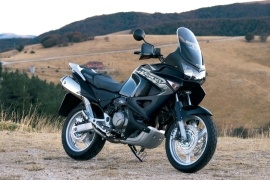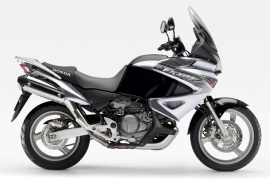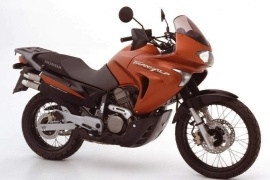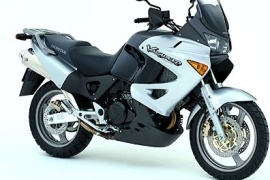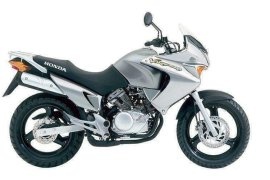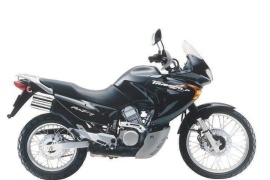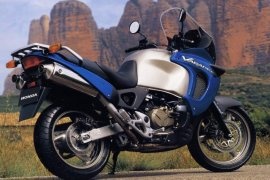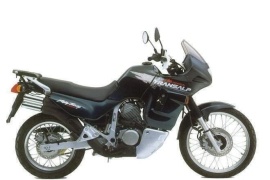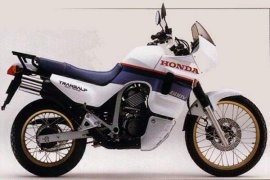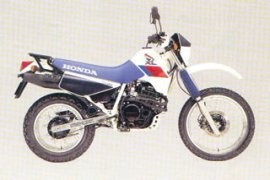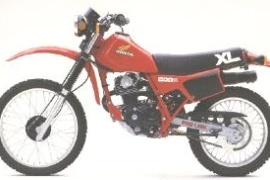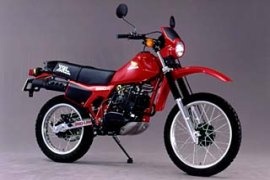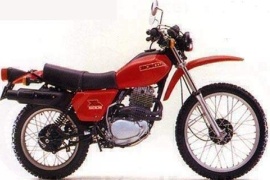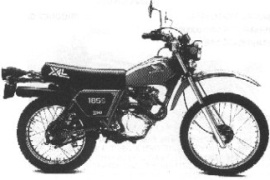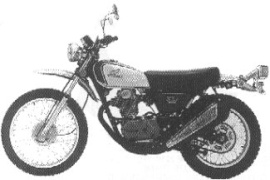HONDA XL Models/Series Timeline, Specifications & Photos
First production year: 1974
In 2008, the Japanese maker released the Honda XL1000V Varadero. The bike had many new upgrades and features, enhancing its style, convenience, and long-term riding comfort and enjoyment.
The Honda XL1000V Varadero was a dual-sport motorcycle produced from 1999 to 2013. In 2003, Honda introduced the fuel injection system, which featured a smooth engine and throttle response, topped off by an ABS modulator.
In the performance department, the 2008 Honda XL1000V Varadero's 996cc liquid-cooled V-twin engine delivered 94 hp at 8,000 rpm and 99 Nm (73 lb-ft) of torque at 6,000 rpm.
The bike featured a new instrument panel with a new dial design for a more attractive appearance, new locking side pockets placed on the sides of the cockpit area, and a new redesigned seat shape for more comfort for the rider and passenger.
Also, the side cover panels were redesigned for more compact and stylish shapes; the tail cowl featured a sleeker design, the under-cowl was replaced with an aluminum unit, and new color variations with two-tone graphics for a more luxurious image.
It was built on a tubular steel frame, with a 43 mm telescopic fork handling the front suspension, while a preload and rebound adjustable shock absorber handled the rear suspension.
The stopping power was generated by two 296 mm discs coupled to three-piston calipers on the front and one 256 mm disc with a three-piston caliper on the rear for solid braking performance.
The Honda XL1000V Varadero was a dual sport motorcycle manufactured from 1999 to 2013. In 2003, Honda introduced the fuel injection system with a smooth engine, throttle response, topped by an ABS modulator.
In 2008, the Japanese maker released the Honda XL1000V Varadero that introduced many new upgrades and features, enhancing its style, convenience, and long-term riding comfort and enjoyment.
The bike featured a new instrument panel with a new dial design for a more attractive appearance, new locking side pockets placed on the sides of the cockpit area, and a new redesigned seat shape for more comfort for the rider and passenger.
Also, the side cover panels were redesigned for more compact and stylish shapes; the tail cowl featured a sleeker design, the under-cowl was replaced with an aluminum unit, and new color variations with two-tone graphics for a more luxurious image.
The stopping power was generated by two 296 mm discs coupled to three-piston calipers on the front and one 256 mm disc with a three-piston caliper on the rear for solid braking performance.
The model was built on a tubular steel frame with a 43 mm telescopic fork handling the front suspension, while a preload and rebound adjustable Pro-Link shock absorber took care of the rear suspension.
As for power, the 2008 Honda XL1000V Varadero delivered a power output of 94 hp at 8,000 rpm and 99 Nm (73 lb-ft) of torque at 6,000 rpm from a 996cc liquid-cooled V-twin engine.
The Honda Transalp was a series of dual-sport machines manufactured by Honda from 1987 and comprised five models such as the XL400V, XL600V, XL650V, XL700V, and XL750. All the bikes from the series were set in motion by a liquid-cooled V-twin engine, except for the XL750, which was powered by a different engine.
In 2000, the XL600V was replaced by the XL650V Transalp, which came with several improvements, such as a power output increase, a 64cc displacement increase, shock absorbers redesigned for road use, an updated exhaust system, one liter larger fuel tank, and a redesigned control panel.
The bike's visual department was characterized by standard features, such as a half fairing with a single headlight unit, a small windscreen, an engine cover, a one-piece dual seat, a luggage rack with integrated passenger handles, a high-mounted exhaust system, and wire-spoke wheels.
For suspension, the motorcycle packed a 41 mm leading-axle telescopic fork on the front with 220 mm of travel and a Pro-Link swingarm with an adjustable shock absorber on the rear with 172 mm wheel travel.
For the power figures, the 2005 Honda XL 650 V Transalp had a 647cc four-stroke liquid-cooled V-twin engine under the fuel tank, delivering 52 hp at 7,500 rpm and 56 Nm (41 lb-ft) torque at 5,500 rpm.
The Honda XL1000V Varadero was a dual-sport machine manufactured by Honda since 1999, while different models were manufactured from 1998 to 2013. The bike had capabilities for long-distance road trips and limited off-road use.
All models were powered by a liquid-cooled V-twin engine. At the same time, in 2001, the Japanese maker introduced the Honda Ignition Security System (HISS), an engine immobilizer similar to the one used on cars.
In 2001, the production of the Varadero model was relocated to Spain, at the Mondes Honda factory outside of Barcelona. In 2003, the bike was launched with several upgrades, increasing torque and fuel efficiency.
The 2003 model featured a fuel injection system, a new six-speed manual transmission, cosmetic changes, and a new instrument cluster. In 2004, Honda introduced ABS and later used it as standard equipment in various markets based on Honda's safety commitment.
In 2004, Honda launched the XL1000V Varadero, a dual-sport machine designed for long-distance touring with a comfortable riding position. The XL1000V was a reliable and capable adventure machine suitable for on-road and light off-road use.
The 2004 Honda XL1000V Varadero had fitted a 996cc DOHC V-twin engine in a twin-spar steel frame, delivering an output power of 94 hp at 8,000 rpm and 99 Nm (73 lb-ft) of torque at 6,000 rpm.
The power produced by the engine was transferred to a six-speed manual transmission that spun the rear wheel to a top speed of 202 kph (125 mph).
The Honda XL125V Varadero was a dual sport motorcycle with a 125cc V-twin engine manufactured by the Japanese maker in 2001. The model's first generation was launched in 2001 in the United Kingdom market for beginner riders.
Due to a marketing study suggesting that riders were attracted by the dual-sport motorcycle idea with a protective noise fairing, Honda began working on a giant 125 machine after the 15 hp restriction on all 125cc motorcycles.
Honda developed a motorcycle with more considerable proportions than most of the 125cc machines, with design cues from the XL1000V Varadero, an 802 mm seat height with a commanding view and enough space for a passenger.
The XL125V was fitted with a 17.5-liter fuel tank and a two-liter reserve, powered by a 124cc four-stroke SOHC V-twin engine, developed initially for the VT125C Shadow cruiser machine.
The bike had a double cradle steel frame fitted with a 35 mm telescopic fork and a preload-adjustable Pro-Link shock absorber on the rear, offering optimum handling and suspension performance.
As for braking performance, the 2001 Honda XL125V Varadero rolled on three-spoke cast aluminum wheels fitted with a dual-piston caliper and a 276 mm disc on the front and a single-piston caliper with a 220 mm disc on the rear.
As for power figures, the machine was set in motion by a 124cc four-stroke liquid-cooled V-twin engine with two carburetors, delivering an output power of 15 hp at 11,000 rpm and 11 Nm (eight lb-ft) of torque at 9,500 rpm.
The Honda Translap was a series of dual-sport machines manufactured by Honda from 1987 and comprised five models, such as the XL400V, XL600V, XL650V, XL700V, and XL750. All the bikes from the series were set in motion by a liquid-cooled V-twin engine, except for the XL750, which was powered by a different engine.
In 2000, the XL600V was replaced by the XL650V Translap, which came with several improvements, such as a power output increase, a 64cc displacement increase, shock absorbers redesigned for road use, an updated exhaust system, one liter larger fuel tank, and a redesigned control panel.
The bike was built on a semi-double cradle box-section steel tube frame fitted with a 41 mm telescopic fork as front suspension. The bike packed a Pro-Link shock absorber on the rear with adjustable compression as rear suspension.
Also, the bike rolled from the factory with wire-spoke wheels fitted with two 256 mm discs and dual-piston calipers acting as front stopping power, while on the rear wheel, the bike was equipped with a single-piston caliper and a 240 mm disc for solid braking performance.
The 2000 Honda XL650V Translap delivered a power output of 52 hp at 7,500 rpm and 54 Nm (40 lb-ft) of torque at 5,500 rpm from a 647cc liquid-cooled V-twin engine fed by two carburetors.
With a five-speed manual transmission and a wet weight of 210 kg (463 lbs), the 2000 machine hit a top speed of 170 kph (106 mph).
The Honda XL1000V Varadero was a dual-sport motorcycle manufactured by Honda from 1999, while different models were produced from 1998 to 2013. In 2003, the Japanese maker introduced fuel injection with a smoother engine and throttle response.
The XL1000V Varadero Adventure Touring machine was introduced at the 1998 Munich Motorcycle Show as a 1999 model with a powerplant based on the Honda VTR1000F Firestorm or Superhawk.
All versions were powered by a liquid-cooled V-twin engine. At the same time, in 2001, Honda introduced the Honda Ignition Security System (HISS), an engine immobilized similar to the one used on cars.
In 2001, the Varadero production was moved to the Spanish Montesa Honda factory outside Barcelona, while in 2003, the bike received some significant revisions, improving torque and fuel efficiency.
Some of the upgrades included the fuel injection system that replaced carburetors, the addition of a six-speed manual transmission, cosmetic changes, a new instrument panel, and ABS, which was introduced in 2004.
The twin-spar steel frame was fitted with a 43 mm telescopic fork for a front suspension and a spring preload and rebound adjustable Pro-Link shock absorber that handled the rear suspension.
The 1999 Honda XL1000V Varadero was powered by a 996cc liquid-cooled V-twin engine and two Keihin carburetors, boasting an output power of 94 hp at 8,000 rpm and 99 Nm (73 lb-ft) of torque at 6,000 rpm.
The Honda Translap was a series of dual-sport motorcycles manufactured in 1987. The series comprised the XL400V, XL600V, XL650V, XL700V, and the XL750, powered by a liquid-cooled V-twin engine, except for the XL750 machine, which had a different powerplant.
In 1985, Honda built the first prototype as an off-road motorbike with a 500cc engine, while further development introduced an increased 600cc engine with more road-oriented features and an improved fairing.
The Honda XL600V was manufactured in 1986 and made available for the American market in 1989. The first version delivered 50 hp at 8,000 rpm, while for the 1989 and 1990 models, Honda increased the output power to 55 hp, returning to 50 hp for the later models.
The bike had some improvements over the years, such as the rear drum brake unit, which was replaced by a 240 mm disc with a single-piston caliper in 1991, the original square headlight replaced, and a new fairing in 1994.
In 1996, the bike was fitted with 34 mm carburetors, and a microprocessor design replaced the CDI ignition. Also, in 1997, the front brake received a second disc, and the diameter was reduced to 256 mm.
Regarding power, the 1999 Honda XL600V Translap had a 583cc liquid-cooled V-twin engine with two Keihin Carburetors, delivering a power output of 50 hp at 8,000 rpm and 53 Nm (39 lb-ft) of torque with a peak at 6,000 rpm.
The Honda Transalp was a series of dual-sports motorcycles manufactured by Honda from 1987 until the Present. The series comprised the XL 400 V, XL 600 V, XL 650 V, XL 700 V, and XL 750 models. With the exception of the XL 750, all models in the range were powered by a V-twin liquid-cooled engine.
The first prototype model was manufactured in 1985 as an off-road motorcycle powered by a 500cc engine, while further development introduced a 600cc version with more road-oriented features, such as an improved fairing.
In 1987, the Japanese motorcycle manufacturer introduced the Honda XL 600 V Transalp, a faired motorcycle fitted with features such as a half fairing with a rectangular headlight, a small windscreen, a one-piece dual seat, a luggage rack, an engine cover, and gold-finished wire-spoke wheels.
The 1987 Honda XL 600 V Transalp's heartbeat was set by a 583cc four-stroke liquid-cooled V-twin engine that delivered 50 hp at 8,000 rpm and 53 Nm (39 lb-ft) torque at 6,000 rpm.
The suspension system comprised a 41 mm telescopic fork on the front with 200 mm wheel travel and a Pro-Link swingarm tied to a monoshock with 187 mm wheel travel on the rear, offering excellent handling.
A 276 mm brake disc clamped by a hydraulic caliper stopped the 21-inch front wheel, and a 130 mm drum braking unit assisted the 17-inch rear wheel.
The Honda XL 600 was an off-road motorcycle made by the Japanese manufacturer from 1983 to replace the Honda XL 500 until 1987, when it was replaced by the Honda NX 650 Dominator. The bike was available in 1983 XL 600 R, 1985 XL 600 LM, and 1986 XL 600 RM versions.
In 1986, the Japanese motorcycle maker introduced the Honda XL 600 RM, a motorcycle that combined the LM model's comfortability and the R model's off-road agility. The fuel tank was reduced to 12 liters, the seat was modified, and the dual starter was retained.
Visually, the motorcycle packed standard fittings, like a single headlight integrated into a small cowl, a high-mounted front fender, a one-piece dual seat with passenger grab handles, a luggage rack, an engine plate, and wire-spoke wheels.
The bike's suspension system comprised a 41 mm Showa telescopic fork mounted on the front and a Pro-Link swingarm tied to a single shock absorber on the rear, providing optimum suspension performance and handling capabilities.
The braking power was achieved by a single 256 mm brake disc mounted on the front wheel and a drum braking unit mounted on the rear wheel.
As for power, the 1986 Honda XL 600 RM had installed a 591cc four-stroke single-cylinder air-cooled engine at its core, delivering 44 hp at 6,500 rpm and 49 Nm (36 lb-ft) torque at 6,000 rpm.
In 1983, the Japanese motorcycle maker released the Honda XL 200R, a naked enduro motorcycle with dirt-riding amenities such as a long travel suspension and a narrow four-stroke single-cylinder engine.
The bike's aesthetic department was characterized by standard features, such as a small round headlight upfront, a high-mounted front fender, analog instruments, a two-up seat, a blacked-out exhaust system with a silencer mounted high on the right-hand side, a Pro-Link swingarm, an engine plate, and wire-spoke wheels.
For suspension, the motorcycle packed a 38 mm air-assisted Showa telescopic fork on the front and a Pro-Link swingarm coupled to dual shock absorbers on the rear, offering optimum suspension performance and handling capabilities.
The bike's braking system consisted of a drum braking unit mounted on the 21-inch front wheel and a drum unit on the 18-inch rear wheel, providing optimum braking performance.
As for power, the 1983 Honda XL 200R had its heartbeat set by a 195cc four-stroke air-cooled single-cylinder engine mounted under the fuel tank, delivering an output power of 18 hp with maximum strength at 8,000 rpm and 17 Nm (12 lb-ft) torque at 6,500 rpm.
A final chain drive linked to a five-speed manual transmission engaged the rear wheel, taking the power from the engine and putting it into motion.
The XL250R is an enduro type bike which has an air cooled, four stroke, single cylinder, 249cc engine developing 22 horsepower at 7500rpm.
The Honda XL 500 was a half-liter enduro motorcycle manufactured from 1979 until 1981 and sold worldwide as the Honda XL 500S. Since 1982, Honda has offered a modified base model version under the XL 500R designation.
Since its introduction in 1979, the bike was recognizable after its swingarm with two spring struts, a 23-inch front wheel, an 18-inch rear wheel, a six-volt alternator, and a simplex drum braking unit. The bike was available in SZ, SA, and SB versions.
In 1979, the Japanese maker launched the Honda XL 500, a naked enduro motorcycle fitted with standard fittings, like a high-mounted front fender, a small round headlight upfront, a one-piece dual seat, a right-hand side high-mounted exhaust system, an engine plate, and wire-spoke wheels.
For suspension, the motorcycle packed a leading axle coil spring fork on the front and a swingarm coupled to two preload-adjustable shock absorbers on the rear, offering optimum suspension performance and handling capabilities.
In the braking department, the motorcycle's wire-spoke wheels were fitted with a 140 mm drum braking unit on the front and a 130 mm drum braking unit on the rear, offering optimum stopping power.
As for the power figures, the 1979 Honda XL 500's heartbeat was set by a 497cc four-stroke single-cylinder air-cooled engine mounted underneath its fuel tank. The engine delivered 32 hp at 6,500 rpm and 37 Nm (27 lb-ft) torque at 5,000 rpm.
The Honda XL 185S was an enduro motorcycle manufactured by Honda in 1979 to replace the Honda SL250. It was produced until 1999 when it was replaced by the Honda XL 200 R. The bike was available in a single color, Monza Red.
In 1979, the Japanese motorcycle manufacturer launched the Honda XL 185S, an enduro motorcycle fitted with features such as a high-mounted front fender, a round headlight, a one-piece dual seat, a high-mounted exhaust system, side-mounted rear shocks, a side stand, and wire-spoke wheels.
The bike was made around a semi-double-cradle steel frame, with a 38 mm air-assisted Showa fork on the front that provided 200 mm of travel and a Pro-Link swingarm tied to twin Showa socks on the rear that offered 165 mm wheel travel.
The braking performance was achieved by a 110 mm drum unit mounted on both front and rear wheels, offering optimum braking power.
The 1979 Honda XL 185S had installed a 180cc four-stroke single-cylinder air-cooled engine under the fuel tank, boasting 16 hp with a peak force at 8,000 rpm and 15 Nm (11 lb-ft) torque at 6,500 rpm.
The engine was assisted by a five-speed manual transmission linked to the rear wheel by a final chain drive, launching the motorcycle to a top speed of 138 kph (86 mph).
In 1974, the Japanese motorcycle manufacturer released the Honda XL 350, a naked motorcycle produced for five years from 1974 until 1978. The small machine was an immediate success for casual riders.
The 1974 model came in a single color: Metallic Silver with blue stripes, silver fuel tank, fenders, headlight housing, matte black side covers, and orange and white XL350 decals.
The visual department was characterized by standard features, such as a high-mounted front fender, a single seat, a single exhaust system with a silencer on the right-hand side, and wire-spoke wheels with off-road tires.
The bike was built around a steel frame with a telescopic fork handling the front and a swingarm coupled to dual shock absorbers handling the rear end, providing optimum suspension performance and handling capabilities.
As for the braking power, the bike's 21-inch front wire-spoke wheel was fitted with a 160 mm drum braking unit, and the 18-inch rear wheel had a 140 mm drum braking unit.
In the performance department, the 1974 Honda XL 350 had installed a 348cc four-stroke single-cylinder air-cooled engine at its core, boasting 22 hp with a peak force at 7,500 rpm and 23 Nm (17 lb-ft) torque at 3,000 rpm.
The engine was fed by a single 32 mm Keihin carburetor and was assisted by a five-speed transmission with a wet multi-plate clutch and a final chain drive.
